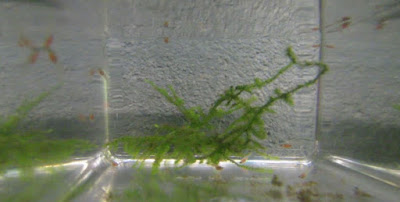Aphyosemion celiae is an endangered species of killifish, known from two localities close to each other in Cameroon. See my video on food and localities here: Our local water is similar to the water in their natural habitat, since both flow through volcanic rocks (basalts) and laterite (red clay) soils. We use a common water source for all
eggs and fish, a cycled 55 gallon tank with plants, fish, and snails.
 |
| A 55 gallon cycled tank for common water |
A. celiae will lay eggs on synthetic mops. We have two mops for each pair. Symbols specific to each pair are written on the cork with magic marker.
The male watches for Drosophila
 |
| A mop dipped in boiling water. It will be cooled in stock water before use. |
We put the cooled second mop in before removing the old mop with eggs. This reduces stress in the fish, as it provides shelter during the disturbance.
With heavy feeding and a water change from the common water, the female watches the male's courtship dance and follows him into the mop.
 |
| Our female colors up as she watches her mate's courtship dance. There is a video on my YouTube site here: https://www.youtube.com/watch?v=xLD62PIoat4 |
Start, then click the box lower left to enlarge
ON SOME BROWSERS CLICK 2X
Later we will have a video on water changes. Notice from the picture we don't use filters in the 2.5 gallon intensive breeding tanks, instead we rely on weekly 80% common water changes. If the breeding tanks need cleaning they are partially emptied, placed on the bench, the fish are netted with a soft net and placed into an already cleaned and scalded replacement tank with common water and mops. The old tank is scrubbed with a plain plastic pad, rinsed with very hot tap water (110 F), Scalded with boiling water, dried with paper towels, partially refilled with common water, and a clean mop added when needed. This procedure resulted in the courtship depicted above.
 |
| A glass Petri dish holding half the eggs from one mop. Note the letter C marked from the underside, code for A celiae |
We gently pull the eggs away from the yarn, then drop then into the water. The photo shows seven A. celiae eggs collected from a small mop on 25 July 2017. Notice that three of the eggs are darker. When the eggs are near hatching, you can see the eyes.
The cover glass gets a paper tape
label, including the species code CEL for A. celiae, the number of
eggs circled, and for A. celiae, the letters MB for methylene blue.
 |
| Click to enlarge.Some "eyed up" eggs and two hatched fry. |
When they hatch, fry and eggs are moved
to a Pyrex bowl in stock water, and labeled. Then the eggs are returned
to their petri dish. In a few species the fry are slow enough to catch with a blunt eye dropper, for example here:
ON SOME BROWSERS CLICK 2X
The second day the fry are fed newly
hatched brine shrimp.
Perhaps you would like to count the fry? Try the video:
ON SOME BROWSERS CLICK 2X


